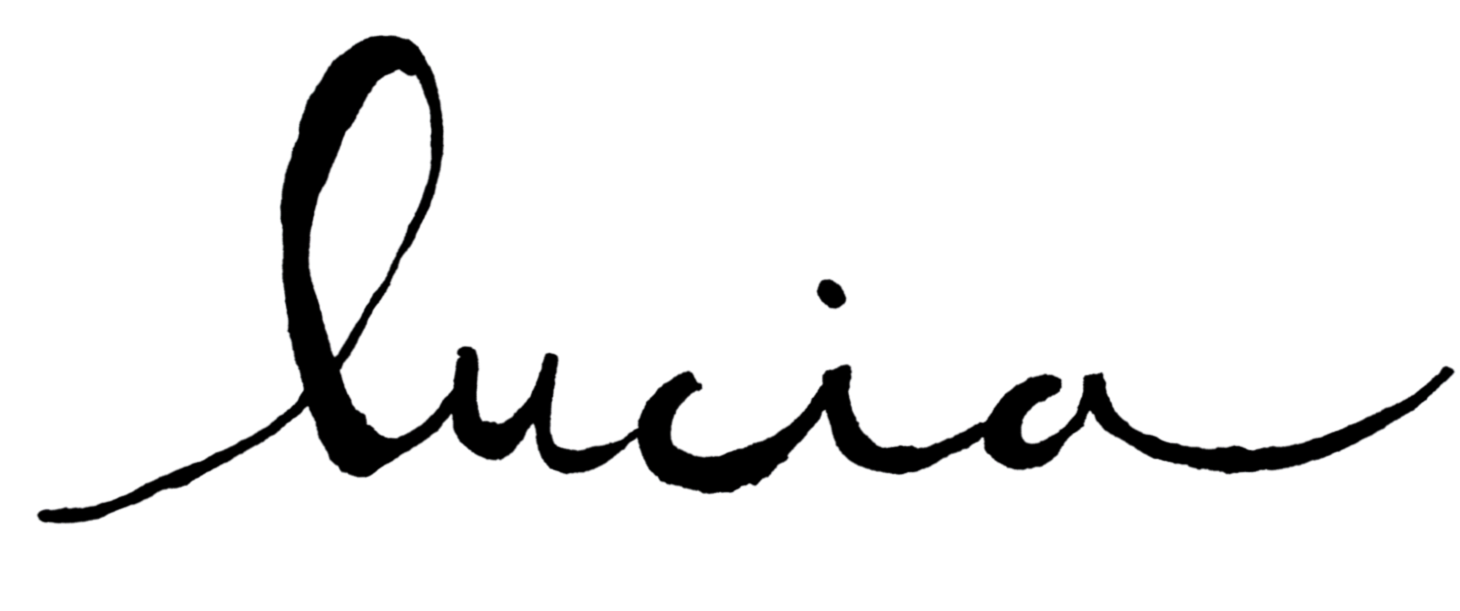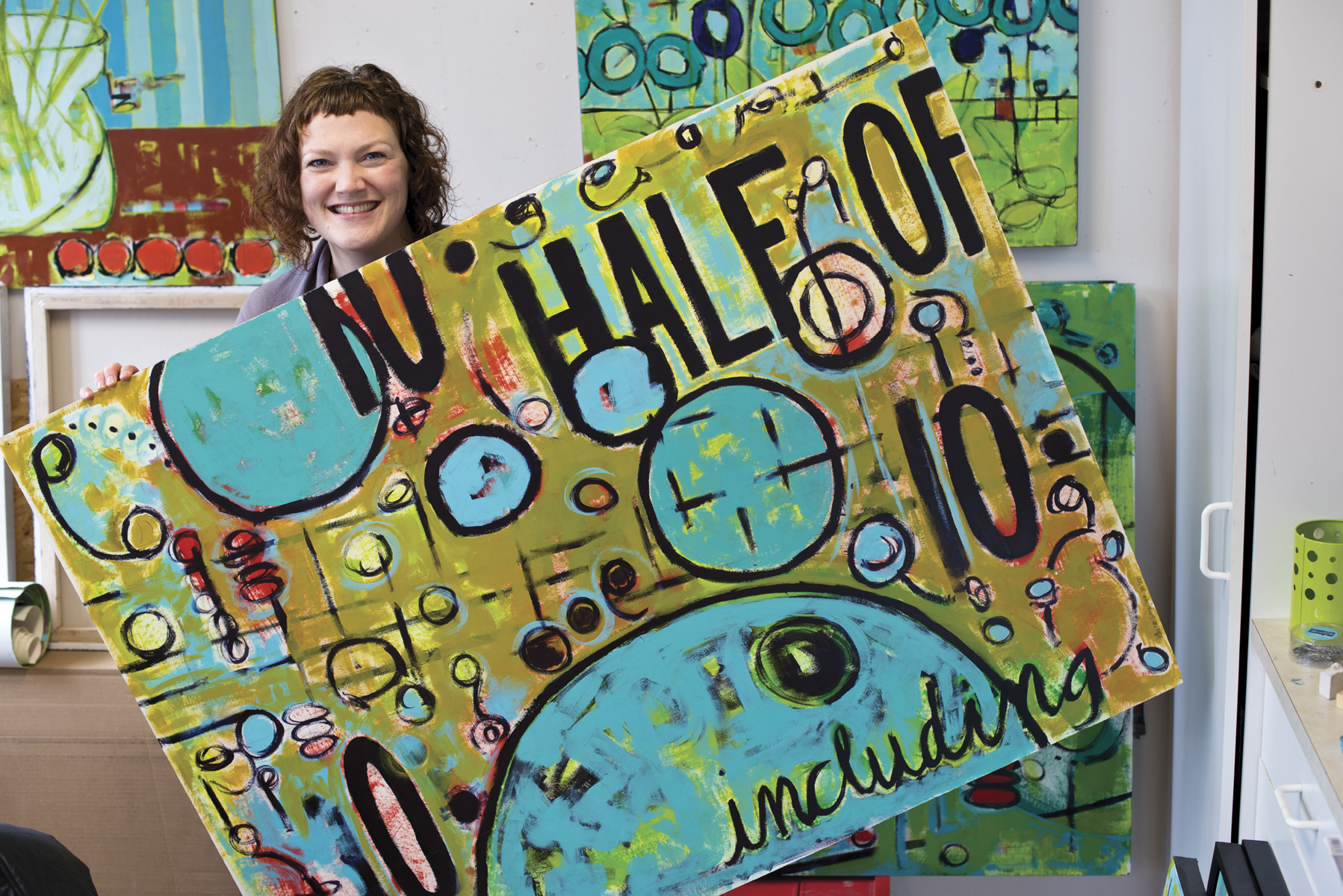“Kelly Rae Cunningham’s West Seattle studio is bright, filled with possibility, and dotted with color. Ask her what inspires her most-loved work and she will smile and show fabrics, photographs, circles, and colors. Her approach to art will dust you with permission to create anything you want, for no reason other than to make something beautiful.”
By Laura Lowery
We both agree. Blank canvases are intimidating.
“I started a long time ago doing underpaintings. I was intimidated by a big white space, so I would just mess it up and then paint over it completely,” she admits.
I wonder out loud whether that’s why so many half-finished journals occupy my bookshelf.
“Mine too!” she squeals, and shows me her current one. “Look at all these empty pages. Just a quarter of them are filled. And I want to start a new one. Why is that?”
Last winter, a designer told me that negative space is important. We feel good when there is space. Our thoughts need room to breathe.
“My best mentor told me that I overpaint,” says Kelly Rae. “It resonated with me, I absolutely was doing that. Things were too tight. They needed more room. So I started leaving more of the underpainting visible. I like what that does.”
Kelly Rae Cunningham is sunshine on a cloudy day. Outside it’s raining, but inside her studio feels bright, filled with possibility, dotted with color.
I explain to her (nervously, because it’s my first “real” interview with an artist) that I’d like to hear about her relationship with inspiration.
She listens, tilts her head to the side, and doesn’t say anything at first. No grand quotable phrases or platitudes come out of her mouth. She does not try to fill the space left by my question with words.
She simply inhales, stands up, and walks to a cardboard box.
Her studio walls are filled with large paintings of abstract flowers, dots and lines on Tiffany-blue backgrounds, with brilliant red blooms and energetic green leaves. She’s had several shows here in Seattle, and some big commissions that hang in various spots around the city, so I’m familiar with her style. She’s known for it.
But inside the cardboard box is something different. Something new. Small square watercolors with patterns that repeat in rich earth tones; sapphire, amethyst, topaz and emerald.
“I love fabrics,” she says, “I have a bunch of fabric from when I traveled in West Africa. A year ago I started doing these watercolor patterns that remind me of it. I did them at the table in our kitchen, when the baby was new, while she napped.”
She calls them kitchen table watercolors.
“We have a tiny house, three people and a dog. And I’m kind of a neat freak, so when the baby went to sleep I would just pull these small squares out and make patterns with color.”
She tells me about being a dancer with a West African dance company for 10 years in Burlington, Vermont. She’s traveled to Mali, Senegal, and the Ivory Coast.
“When I moved here to Seattle, it fell off. But I’ve been missing it. A lot of this work reminds me...” (her voice trails off).
As we move around her studio, she offers glimpses of what inspires her. She shows more than tells. Her face lights as she goes and I see something glow inside of her like a pilot light, just waiting for the next spark.
She opens a container of vibrant pink, selects a brush with a long handle, and begins to paint a work-in-progress hanging on her wall. I silently marvel at her effortless strokes. Her movement feels lighthearted, fun.
“There are a lot of artists I follow on Instagram. A lot of them in the South,” she says as she paints the outline of a pink flower. “There’s this woman who does florals. Messy, loose abstracts that I love. She uses this pink color, so I was just sort of following her palette.”
I ask whether there is an underlying theme or principle that guides her work. Her response is humble.
“I’ll read a lot of artist statements from people who have a philosophical way of approaching their work. And I don’t have that,” she laughs.
“I’m not trying to tell anyone anything with my paintings. A lot of it is about playing with color, because I love it. And a lot is the physical act of painting.”
She tells me about her ritual: Squeezing out the paint; creating her specific mixture of things she’s figured out over the years, different pastes, gels, how much gloss she wants or doesn’t want; the glass tray where she mixes it all and makes a big mass of color.
“And then, it turns into this!” she radiantly points to one of the paintings on the wall.
“A lot of it is just about the process, and the physicality of doing it. Yes, there are circles and flowers but I don’t...I’m not trying to say anything with it.”
I tell her it feels to me as though her art, and her process, give us all more permission to explore and create art for the fun of it. Besides, do we really need to be that serious all the time?
“I don’t think we do,” she says. “For me, it’s about wanting to make beautiful spaces.”





